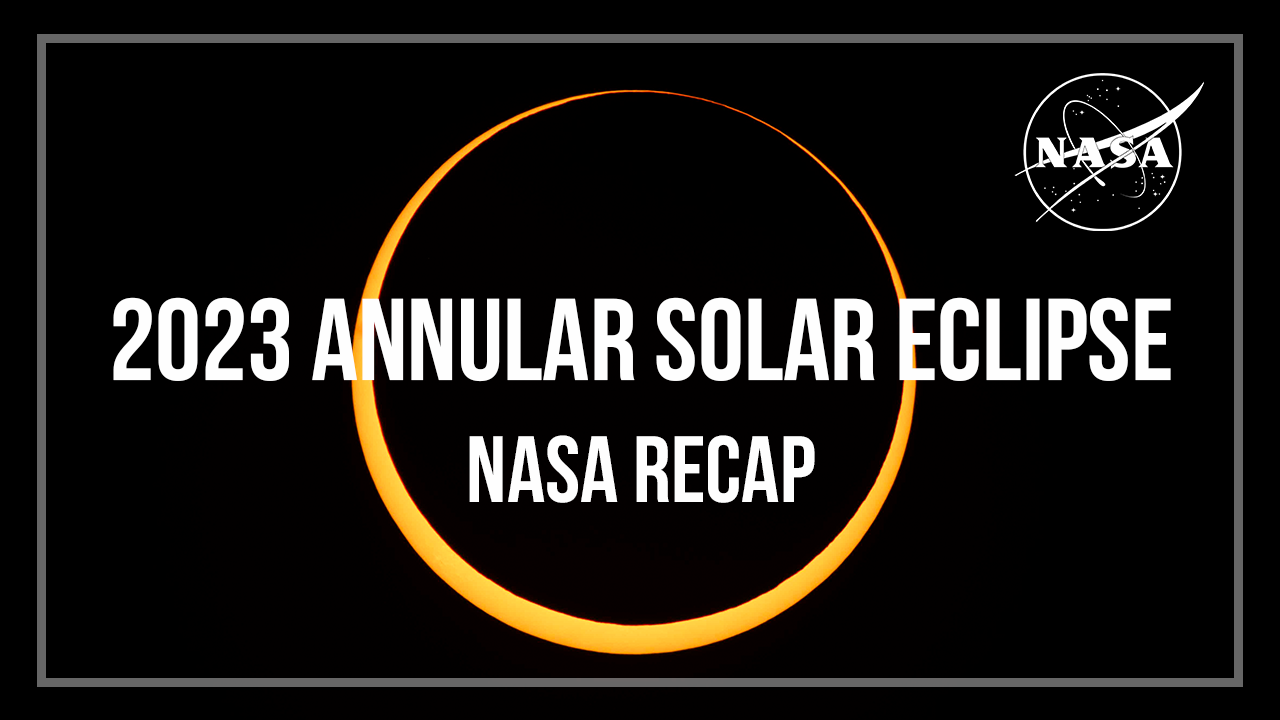The 2023 Annular Solar Eclipse

The path of annularity and partial contours crossing the U.S. for the 2023 annular solar eclipse occurring on October 14, 2023.
This map illustrates the paths of the Moon’s shadow across the U.S. during the 2023 annular solar eclipse. On October 14, 2023, an annular solar eclipse will cross North, Central, and South America creating a path of annularity. An annular solar eclipse occurs when the Moon passes between the Sun and Earth while at its farthest point from Earth. Because the Moon is farther away from Earth, it does not completely block the Sun. This will create a “ring of fire” effect in the sky for those standing in the path of annularity.
Making the Map
This map uses datasets from several NASA missions. The eclipse data were calculated by visualizer Ernie Wright using elevation information from SRTM, lunar topography from LRO, and planetary positions from the JPL DE421 ephemeris. The lead visualizer, Michala Garrison, used Earth imagery from NASA’s Blue Marble Next Generation to create the terrain map.Reading the Map
The dark path across the map is where the largest area of the Sun will be covered by the Moon. People in these paths will experience an annular solar eclipse. Inside the dark eclipse path are irregular ovals that delineate the Moon’s shadow on the Earth’s surface. For an annular solar eclipse, these ovals are called the antumbra and together make up the path of annularity. On the map, the ovals contain times inside corresponding to the shape of the Moon’s shadow cast at that time during the eclipse.Also within the dark paths are duration contours. These delineate the length of time annularity will last. The closer to the center of the solar eclipse path, the longer it will last. For the annular path, times range from a few seconds on the outer edge to a maximum of around 4.5 minutes in the center.
Outside the eclipse path, the map displays contours of obscuration, or percentage of the Sun’s area covered by the Moon. Readers can trace the lines to percentages printed along all sides of the map that range from 85% to 10% obscuration. The dark path marks when 90% obscuration begins.
Download Eclipse Data
2023 Annular Eclipse Data: 2023eclipse_shapefiles.zipThe .zip file above contains the following files:
- center.shp A high-resolution polyline tracing the path of the shadow center. Region limited.
- duration.shp Isocontours of maximum annular duration, at 30-second intervals.
- ppath.shp “Penumbra path,” contours of maximum partial obscuration (area of the Sun covered by the Moon) at 5% intervals.
- ppath01.shp “Penumbra path,” contours of maximum partial obscuration (area of the Sun covered by the Moon) at 1% intervals.
- umbra_hi.shp High resolution antumbra polygons, at 1-second intervals. Region limited.
- umbra_lo.shp Lower resolution antumbra polygons, at 10-second intervals. Global.
- upath_hi.shp High resolution path shape. Region limited.
- upath_lo.shp Lower resolution path shape. Global.
More Map Versions

Same map with no QR code.

Same map with no text.
Credits
Please give credit for this item to:
NASA's Scientific Visualization Studio
-
Visualizers
- Michala Garrison (SSAI)
- Ernie Wright (USRA)
-
Technical support
- Laurence Schuler (ADNET Systems, Inc.)
- Ian Jones (ADNET Systems, Inc.)
Release date
This page was originally published on Monday, July 10, 2023.
This page was last updated on Thursday, October 10, 2024 at 12:15 AM EDT.
Datasets used
-
[LRO: LOLA]
ID: 214 -
DEM [SRTM: SIR-C]
ID: 481 -
Blue Marble Land Cover [Terra and Aqua: MODIS]
ID: 510Credit: The Blue Marble data is courtesy of Reto Stockli (NASA/GSFC).
See all pages that use this dataset -
DE421 (JPL DE421)
ID: 752Planetary ephemerides
This dataset can be found at: http://ssd.jpl.nasa.gov/?ephemerides#planets
See all pages that use this dataset -
Black Marble (Black Marble: Next Generation) [Suomi NPP: VIIRS]
ID: 1176Earth at night imagery
Credit: NASA Earth Observatory images by Joshua Stevens, using Suomi NPP VIIRS data from Miguel Román, NASA GSFC.
This dataset can be found at: https://visibleearth.nasa.gov/images/144898/earth-at-night-black-marble-2016-color-maps/144947l
See all pages that use this dataset
Note: While we identify the data sets used on this page, we do not store any further details, nor the data sets themselves on our site.

![VERTICAL VersionMusic Credit: “Tall Grass” by Jacob Paul Turner [BMI], Marc Pueschl [GEMA], Sebastian Barnaby Robertson [BMI] via Universal Production MusicComplete transcript available.](/vis/a010000/a014300/a014390/AnnularEclipseSafety_Thumbnail-VERTICAL_print.jpg)
